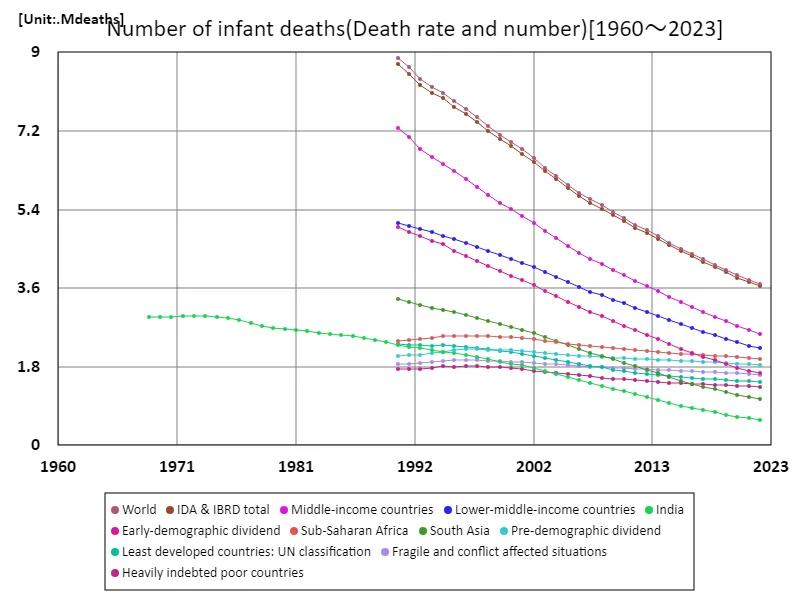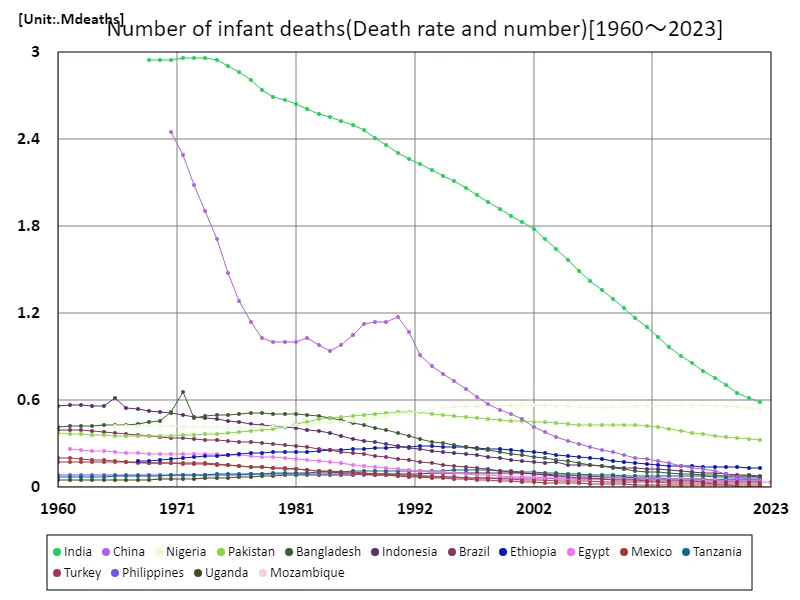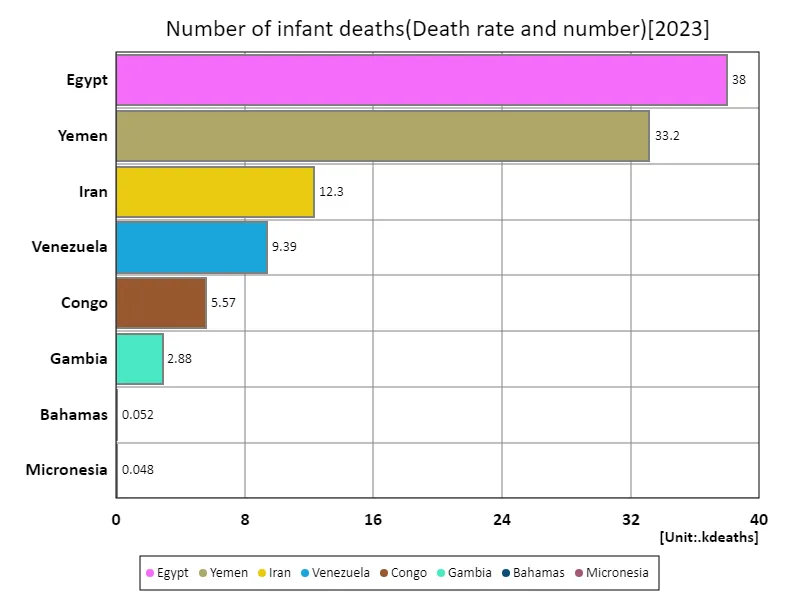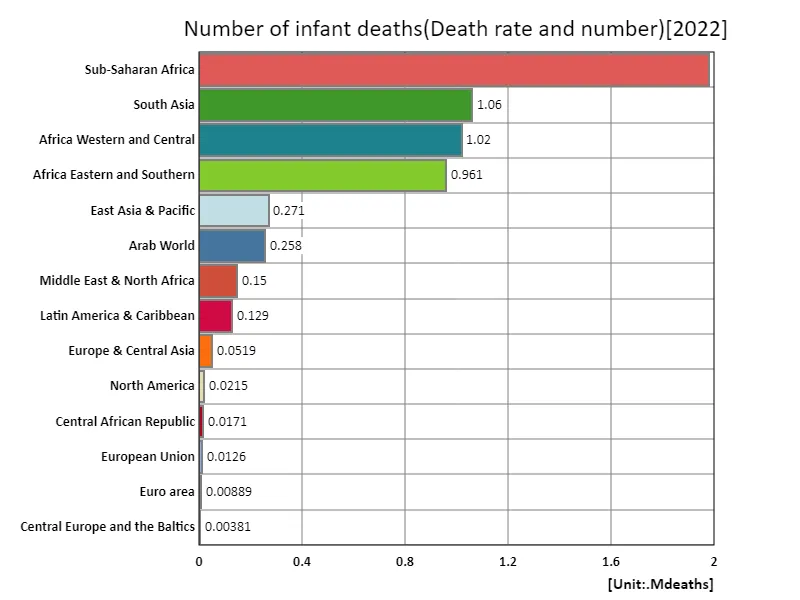Abstract
According to 2022 data, global infant deaths have reached 3.7 million. While this is still a sobering figure, there has been notable improvement over the past few decades. This improvement is particularly remarkable because infant mortality rates were higher in the 1980s. This improvement is due to advances in medical technology, widespread vaccination, and improved maternal and child health. However, regional disparities persist, with infant mortality rates remaining high in low-income countries and conflict zones. In particular, high infant mortality rates are reported in Africa, making economic development and the allocation of medical resources a challenge. In addition, the effects of climate change and pandemics may also affect infant health, requiring further measures. Continued international cooperation and addressing local issues will lead to further reductions in infant mortality.
Infant deaths
Data from 1968 to 2022 shows that the number of infant deaths worldwide has undergone significant changes. The population peaked at 8.87 million in 1990, but by 2022 it had fallen to 3.7 million, or 41.7% of that figure. This change is due to a variety of factors, including advances in medical technology, improved public health, and widespread vaccination. From the 1970s to the 1980s, there was a significant disparity between areas with high and low infant mortality rates, but since the 1990s, infant mortality rates have declined in many countries. This improvement is due to the widespread use of antibiotics, the expansion of maternal and child health programs, and improved nutrition. However, regional disparities remain, with infant mortality rates remaining particularly high in sub-Saharan Africa. Additionally, in recent years there have been concerns that the effects of climate change and pandemics may affect infant health. Future challenges will require fair allocation and sustainable development of medical resources. International cooperation and localized measures remain necessary.


The maximum is 8.87Mdeaths[1990] of World, and the current value is about 41.7%
Infant deaths (worldwide)
Data from 1960 to 2023 shows that there has been a notable decline in infant deaths in India. The population peaked at 2.96 million in 1972, but has now fallen to just 19.8% of that figure. This dramatic improvement is the result of a wide range of measures, including strengthening health systems, promoting vaccinations and implementing nutritional improvement programmes. During the 1970s and 1980s, India faced high infant mortality rates, but has seen rapid improvement since the 1990s. Government health policies and international aid played an important role, especially in the 1990s and early 2000s. Recently, there has been progress in efforts toward the Sustainable Development Goals and in health management using digital technology. However, disparities remain between regions and between urban and rural areas, and improvement has been slow in some regions, so region-specific measures continue to be necessary. Climate change and economic instability may also have an impact, calling for comprehensive responses to these challenges.


The maximum is 2.96Mdeaths[1972] of India, and the current value is about 19.8%
Infant deaths (worldwide, latest year)
According to data for 2023, the total number of infant deaths worldwide will be 102,000, with an average of 11,300. Egypt recorded the highest figure of 38,000, illustrating the regional disparity in infant mortality rates. In recent years, the number of infant deaths has been declining overall, but there are significant regional differences. In some low- and middle-income countries, such as Egypt, where the figures are particularly high, lack of medical resources, infectious diseases and malnutrition remain major issues. On the other hand, in developed countries and some developing countries, infant mortality rates have fallen significantly due to improvements in medical technology and public health. These regional variations reflect the effectiveness of international aid and development programs, as well as differences in national policies. The World Health Organization (WHO) and other international agencies are stepping up support to further reduce infant mortality, especially in resource-limited areas. Important challenges for the future include improving access to medical care, spreading education, and working toward the Sustainable Development Goals. Efforts are needed to reduce regional disparities and ensure that all infants have access to appropriate care.


The maximum is 38kdeaths of Egypt, the average is 12.7kdeaths, and the total is 101kdeaths
Infant deaths (region, latest year)
According to data for 2022, the total number of infant deaths worldwide is 5.95 million, with an average of 397,000. Sub-Saharan Africa recorded the highest number of deaths at 1.98 million, highlighting the high infant mortality rate in the region. Infant mortality remains high in sub-Saharan Africa, mainly due to a lack of health infrastructure, malnutrition and the spread of infectious diseases. Meanwhile, in other regions, the number of infant deaths is decreasing due to advances in medical technology, widespread vaccinations, and improved maternal and child health. For example, some Asian countries and Latin America have seen improvements thanks to effective public health policies and medical interventions. Additionally, regional disparities remain significant, with a serious lack of access to medical care in low-income countries and conflict-affected areas. International support and addressing region-specific challenges are needed to achieve the Sustainable Development Goals. New threats such as climate change and pandemics may also have an impact and require strong strategies and cooperation to respond to these.


The maximum is 1.98Mdeaths of Sub-Saharan Africa, the average is 397kdeaths, and the total is 5.95Mdeaths



Comments